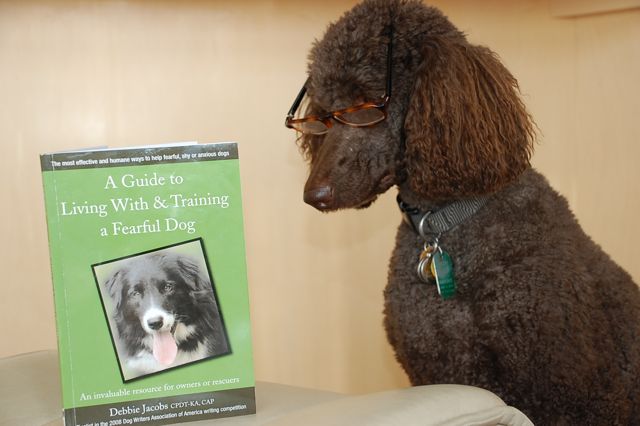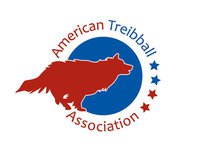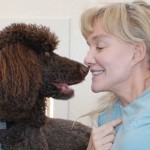I wish dogs could read. I especially wish fearful dogs could read. But, since they can’t, yet, (even though Sadie looks pretty convincing), you’ll want to read Debbie Jacobs’ A Guide to Living with & Training a Fearful Dog on behalf of the fearful dogs in your life.
Almost two years ago, soon after I starting blogging and Tweeting about my fearful Sadie, I found Debbie Jacobs‘ website and blog, Fearfuldogs.com and ordered her e-book, the precursor to A Guide.
Debbie has a gift for taking a dogs-eye-view. This is always a good idea if you love dogs, but absolutely essential if you live with a fearful dog. It’s one of the things I appreciate about Debbie. I know I can trust that what she has to tell me is in the best interest of my dog. That’s why I wish dogs could read. They would feel so understood by her.
Sunny, who graces the cover of the book, is a refugee from both Hurricane Katrina and a hoarding operation. He is the Border Collie that launched Debbie on her quest to discover how to make life as good as it can be for an extremely fearful dog. Debbie wrote the book she wishes she had had when she and Sunny began their journey together. Her Guide gives people with fearful dogs a much needed leg up.
There’s so much good information in this thin volume that I’m not sure where to start. So rather than try to cover the gamut, let me share some points Debbie made that hit home for Sadie and me.
Take stock of how you see your fearful dog. Do you harbor fantasies that your pup will snap out of it one day and turn into the doggie version of “Miss Congeniality”? Forgetaboutit. You’ll likely be disappointed. Adjust your expectations down a few notches for both your own and your dog’s sake. That way you’ll be thrilled by otherwise seemingly small achievements, like I was the first time Sadie didn’t duck and run for cover from a boy speeding past us on his scooter.
Do you think your fearful dog is being willfully aggressive, or worse, dominant, when she barks and lunges at the nice man who crouches over her and reaches out his hand to pat her on the head? I was mortified the first time Sadie did this. Thankfully, our trainer was wise. She, like Debbie, encouraged me to look at it from Sadie’s perspective. Sadie was freaked out. Panicked. Her behavior was reactive and not under her control. Sadie was screaming, “Go away! You scare me!”
What to do? First, do not punish your fearful dog, and do not force your dog to confront her fears.You’ll never earn your dog’s trust that way, and a fearful dog’s trust is golden. Once you earn it, never abuse it or take it for granted.
Debbie suggests using reward-based training to teach your dog skills to manage scary situations. Probably the most important skill Sadie has learned is “touch,” or “targeting” as Debbie refers to it, in which she bonks my hand with her nose. Now when Sadie sees someone or something that makes her uneasy she seeks out my hand for a “touch.” I always generously reinforce Sadie for choosing “touch” with a special goodie.
Change your dog’s brain! Debbie emphasizes that fearful dogs brains can, to varying degrees, be rewired. One way to do this is to help your dog change his fearful emotional reaction to scary things, such as people walking directly towards him.
This was one of Sadie’s triggers. Even if the person wasn’t really aiming for Sadie and just walking towards us, Sadie would freak. I wanted her emotional response to shift from “Yikes!” to “Yippie!” As Debbie recommends, I paired people heading towards Sadie with yummy treats. After many repetitions, people walking towards us predicted good things. Yippee!
All dogs wanna have fun, but fearful dogs gotta play. Another way Debbie suggests changing your fearful dog’s brain is through play. Joyful play releases feel-good brain chemicals such as dopamine. If you’re not sure what rings your dog’s bell, his breed might give you a place to start. For example, Border Collies are born to herd. Ain’t got sheep? Try big exercise balls. They’re great sheep stand-ins. Standard Poodles are water fowl retrievers. Tennis balls and frisbees are Sadie’s and my harmless substitute for dead ducks.
The bottom-line? “Any behavior you want your dog to learn should end up with your dog feeling good!”
I have but one quibble with A Guide to Living with & Training a Fearful Dog. I would have loved more stories about Debbie and her experiences with Sunny.
Tags: A Guide to Living with & Training a Fearful Dog, Classical conditioning, Debbie Jacobs, Dopamine, Fearful dogs, fearfuldogs.com, Flooding, Force, Positive reinforcement, Positive training, Punishment, Reward Based Dog Training, Targeting, Touch













